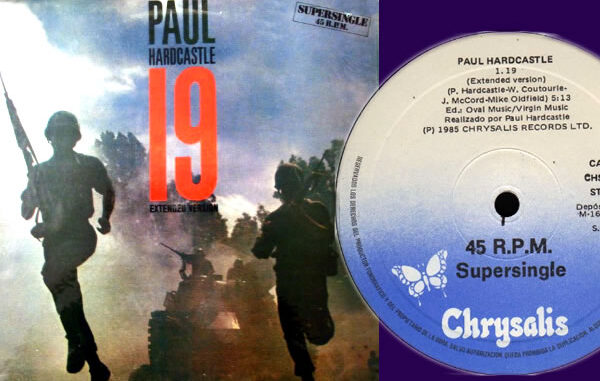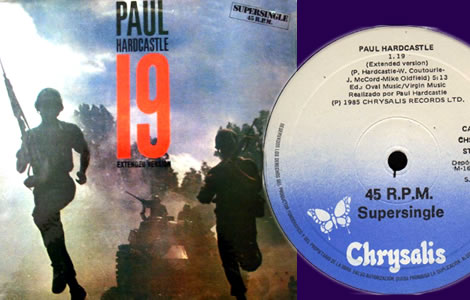
In 1985, Paul Hardcastle released “19,” a groundbreaking hit that profoundly resonated with listeners worldwide.

This song, which became an emblematic piece of the 1980s music scene, addressed the Vietnam War and its harrowing effects on soldiers.
Through its innovative use of electronic music and sampling, “19” delivered a powerful anti-war message that still echoes today.
Theme and Message of “19”
“19” is an anti-war song that focuses on the experiences of young American soldiers during the Vietnam War. The title refers to the average age of U.S. combat soldiers who fought in Vietnam, a fact that struck a chord with many listeners.
The song opens with a voiceover stating, “In World War II, the average age of the combat soldier was 26… In Vietnam, he was 19.” This stark contrast highlights the youth and inexperience of the soldiers, many of whom were barely out of their teenage years.
The lyrics of “19” delve into the psychological trauma faced by these young men, using samples from television documentaries and news reports.
Lines like “They fought the longest war in American history” and “There were those who came back and couldn’t escape the nightmares” vividly depict the lasting impact of the war. The song also touches on the broader societal implications, including the inadequate support for veterans and the widespread protests against the war.
Chart Success Worldwide
“19” was a commercial success, topping charts across the globe. In the UK, it reached number one and stayed there for five weeks, becoming one of the best-selling singles of the year.
In the United States, the song peaked at number 15 on the Billboard Hot 100, but its influence extended far beyond its chart position. “19” also topped charts in several European countries, including Germany, where it was particularly popular.
In Australia, the song reached number one and maintained a significant presence on the charts.
Its international success was a testament to its universal message and the innovative musical approach that Hardcastle employed.
The use of electronic beats, synthesised melodies, and sampled voices set “19” apart from other songs of the era, making it a precursor to the electronic and dance music that would dominate in the following decades.
Political Reaction and Cultural Context of 1985
The release of “19” in 1985 came at a time when the world was grappling with the aftermath of the Vietnam War and the ongoing Cold War tensions. The song’s stark portrayal of the war and its effects on soldiers sparked a range of reactions.
Many praised Hardcastle for bringing attention to the often-overlooked psychological impact on veterans. The song’s critical view of the war and its consequences resonated with the anti-war sentiments that were still prevalent.
However, “19” also faced criticism from some quarters. Certain veterans and conservative commentators felt that the song painted a one-sided picture of the Vietnam War, focusing too heavily on the negative aspects and not giving enough credit to the soldiers’ bravery and sacrifices.
Despite this, the overall reception was largely positive, with many acknowledging the importance of addressing the war’s lingering effects.
The song’s acclaim was also influenced by the contemporary political climate.
In 1985, the United States was under the leadership of President Ronald Reagan, whose administration was marked by a strong anti-communist stance and significant military interventions in various parts of the world.
The memory of Vietnam was still fresh, and “19” served as a poignant reminder of the costs of war. This context helped to amplify the song’s impact, making it not just a hit, but a cultural milestone.
Influence on Future Music
“19” was not just a commentary on past events; it also pointed towards the future of music. Paul Hardcastle’s use of sampling and electronic production techniques was innovative for its time.
The song’s structure, which blended spoken word samples with melodic hooks and electronic rhythms, was groundbreaking. This style would later become a staple in genres such as hip-hop, house, and techno.
The success of “19” demonstrated the potential of electronic music to convey powerful messages and connect with a broad audience. It paved the way for other artists to experiment with technology and production techniques, leading to the rise of electronic dance music (EDM) and other related genres in the 1990s and beyond.
Hardcastle’s influence can be seen in the work of many later artists who have used sampling and electronic beats to create socially conscious music.
19 – musical history in Capitol fm
Paul Hardcastle’s “19” remains a seminal work in the history of music. Its poignant anti-war message, combined with its innovative use of electronic music, set it apart as a groundbreaking hit.
The song’s success on the charts across the world, along with its significant political and cultural impact, underscores its importance.
As a precursor to future music trends, “19” holds a special place not only as a reflection of its time but also as a harbinger of the musical innovations that would follow.
